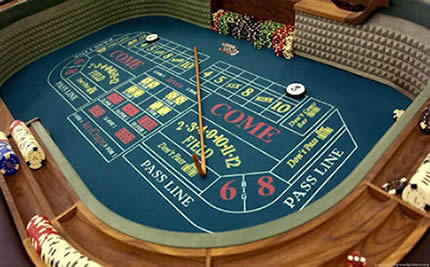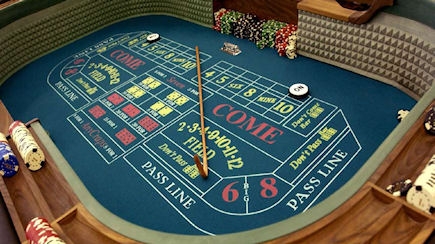Craps is the one of the most exciting games in the casino. It is the one game where nearly everyone is in it together and looking for that one hot shooter who will control the dice for an hour. You should be warned that craps is not the easiest game to learn, but let’s have a look at the very basic strategy of ‘pass’ or ‘win’ line betting and how you can ‘bet behind the line’ for ‘true odds’.
A game of craps begins with the ‘come-out roll’ – the first roll. The most common bet at this stage is on the ‘pass line’ or as it is sometimes called the ‘win line’.
On the ‘come-out roll’ a throw of a 7 or 11 is a natural and wins straight away, getting paid at even money. If you throw a 2, 3 or 12 you instantly lose your bet. Throwing a 2, 3 or 12 is known as ‘craps’ so it’s a bit like baccarat in the sense that the name of the game is not actually a good thing for the player. If a shooter throws craps they are allowed to keep the dice (and put a new bet on the ‘pass line’). The dice won’t pass to a new shooter until the shooter ‘sevens-out’ (explained below).
But what happens when you hit one of the other numbers: 4, 5, 6, 8, 9 or 10? When you roll one of those numbers, you neither win nor lose yet, that number becomes your ‘point’ number. The goal of the game is now simple; you need to roll that number again before you roll a 7. For example, if you roll a 9 that becomes your point number and you now have to roll a 9 again before you roll a 7. If you roll a 9 you have hit the point number, you win your ‘pass line’ bet and you get to start the process again with a new pass line bet and a new come-out roll.

Craps is not the easiest game to learn
If you roll a 7 after a point has been established, you have ‘sevened-out’, your win line bet loses and that roll is over. The dice are then given to the next player to have their turn at throwing the dice. Once a ‘point’ is made don’t ever mention the number 7 as it is considered the worst of all luck. If you roll anything other than your point number or a 7, the roll doesn’t matter (for your win line bet, it might matter for other bets on the table) and you just roll again. 2, 3, 11 and 12 also mean nothing during this ‘point cycle’.
The initial bet put on the ‘pass’ or ‘win’ line are paid at even money. In addition to the ‘pass’ line bet, a player can ‘take odds’ which is a bet that is placed behind the players’ pass line bet. This bet can only be placed once a ‘point’ is established. When you watch a game of craps you will see people placing chips right behind their initial bets. Bets ‘behind the line’ are paid at true odds. That is, there is no house edge on this bet. The odds for ‘behind the line bets’ are different for each of the numbers and are paid as follows:
- 6 and 8 pays 6 to 5
- 5 and 9 pays 3 to 2
- 4 and 10 pays 2 to 1
The odds you can take ‘behind the line’ vary from place to place. It is common in Las Vegas to get 3, 4, 5x odds, which means you can bet 3 times your initial pass line bet on the 4 and 10, 4 times your initial bet on the 5 and 9 and 5 times your initial bet on the 6 and 8. Other casinos might offer different amounts that you can bet ‘behind the line’ so this is one of the first questions you want to ask the casino staff before you start playing. If, for example, they offer 10x odds, you can bet up to 10 times your initial bet (on the ‘pass’ line) ‘behind the line’. This is always a great bet to take and is often called the best bet in the casino as the house is taking no edge on that particular bet. Some casino have even been known to offer 100x odds behind the line!







